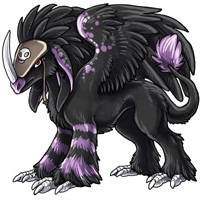Pet Facts



Jinx Facts
|
Jinxes are born from eggs after an incubation period of six to seven weeks.
|
|
Females generally lay only a single egg at a time, but during rare instances, two eggs are produced. The siblings born from such a clutch will be very close to each other, so much so that when they are separated, neither one will be able to function properly. They will refuse to eat and will instead spend all of their time trying to find their lost sibling, being particularly irritable all the while. At night, they will continually let out loud cries that embody their loneliness until they eventually fall asleep from exhaustion. If they are not reunited with their sibling within a reasonable amount of time, they will drive themselves to death. Jinx siblings typically do not outgrow this bond when they reach maturity. Almost all continue to be lifelong companions, even if one (or both) finds a mate and starts a family.
|
|
Jinx eggs are quite tough. Baby Jinxes, themselves, would not be able to crack through their shells without the assistance of their powerful horns and claws, which begin to develop quite early on in the incubation period.
|
|
Both males and females are known for their rebellious natures. They cannot stand to be confined and will lash out at anyone who they perceive as getting in their way. Treats will not sway their opinion of their owners, making them nearly impossible to train. It takes a special kind of owner to win the affection of a Jinx.
|
|
A Jinx's tail is completely prehensile. They can be used for all sorts of tasks, whether it be something as simple as preening their feathers to something more complicated, such as picking up a stick and drawing runes in the ground with it.
|
|
No one knows where Jinxes come from, but some have theorized that on Friday the 13th the mist around Mistica forms strangely in the land creating a portal for Jinxes to pass through into Mistica. (And other specific dates of course!)
|
|
Jinxes are omnivorous and usually keep a steady diet of vegetation and meat.
|
|
Jinxes can fly short distances when needed but they prefer to run and can run up 30 MPH.
|
|
The horn on their nose is used to duel each other during mating times and also to impress each other. Males' horns are judged on how sturdy they are in thickness and durability. Females choose their mates based on their judgment on a males horn, since males are their primary source of protection.
|
|
Females rely on males heavily when they are caring for their young. They will not leave their young alone at any time, therefore it's up to the male to bring food and provide protection for his family.
|
|
A male and female pair will remain a mating pair for life. If either one dies, they other will not find a replacement mate and remain solitary for the remainder of their lives.
|
Go Back
